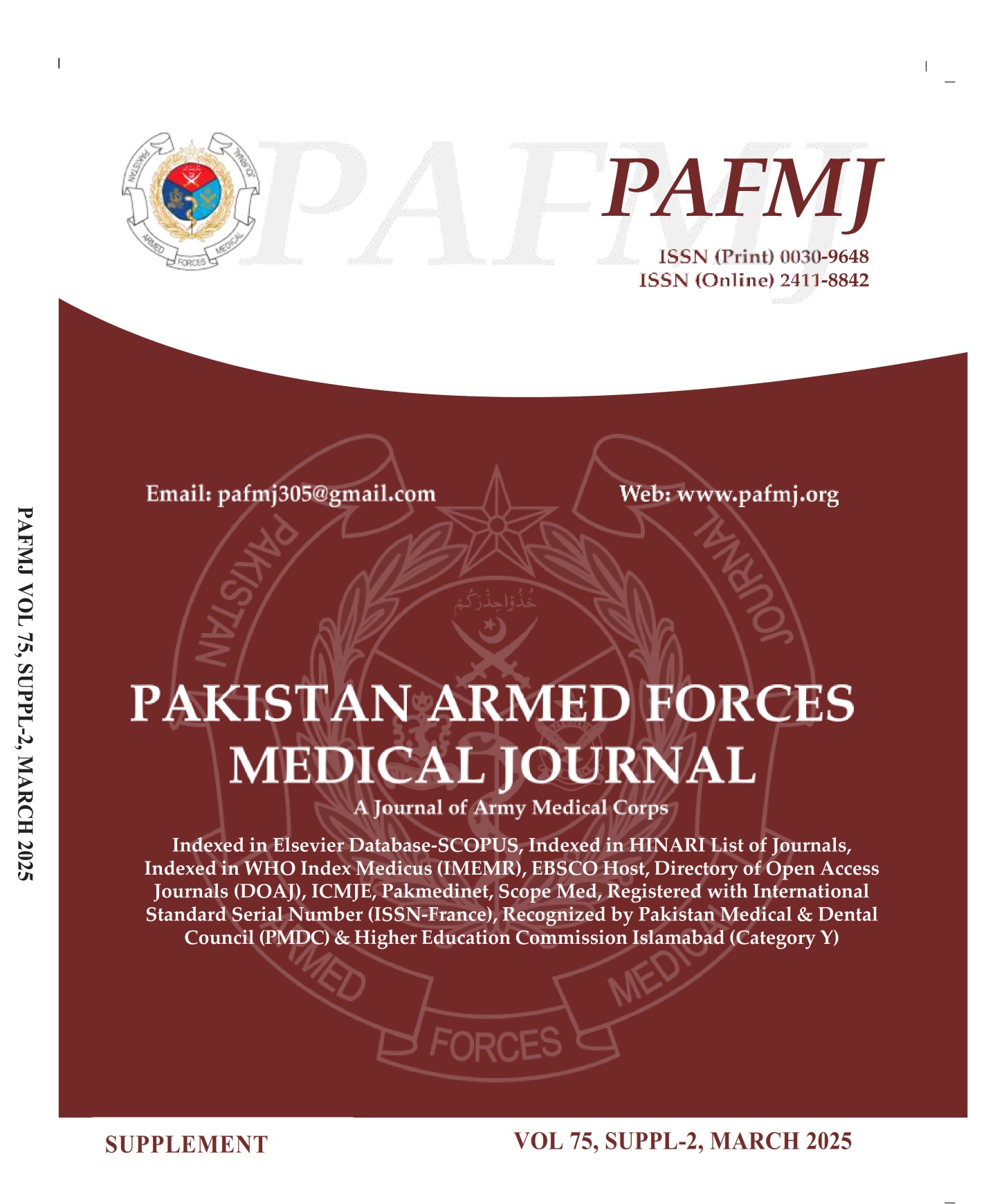Comparison of Factors Associated with Complications in Patients with Mirizzi Syndrome Undergoing Cholecystectomy
DOI:
https://doi.org/10.51253/pafmj.v75iSUPPL-2.9429Keywords:
Cholecystectomy, Morbidity, Mirizzi SyndromeAbstract
Objective: To determine the frequency of post-operative morbidity in terms of wound infection, wound dehiscence, gall bladder fossa collection and post- operative pancreatitis in patients with Mirizzi syndrome undergoing cholecystectomy.
Study Design: Comparative cross-sectional study.
Place and Duration of Study: Department of General Surgery, Combined Military Hospital, Peshawar Pakistan, from Apr 2019 to Feb 2022.
Methodology: A total of 150 patients of age 20-70 years of either gender, diabetics and undergoing cholecystectomy for Mirizzi syndrome were included. Cholecystectomy was done in every patient. After surgery patients were shifted to post-surgical wards and were evaluated for wound infection, dehiscence within 24 to 48 hours while their stay in the ward. Ultrasound was performed after 24 hours to check for Gall bladder fossa collection. After 48 hours of procedure, patients were discharged and were followed in OPD for up to 2 months and Post-op morbidity was noted.
Results: Out of 150 patients of Mirizzi syndrome studied, 32(21.3%) showed any one of more complications while 128(78.7%) did not show any complication. Mean age of the study participants was 41.45±8.75 years. Wound infection was found in 16(10.6%) patients, wound dehiscence in 07(4.6%) patients, gall bladder fossa collection in 03(2%) patients and post-operative pancreatitis in 06(4%) patients. Method of surgery had statistically significant relationship with presence of complications among study participants (p-value<0.05).
Conclusion: This study concluded that these complications were found in considerable no of patients managed for Mirizzi syndrome. Male patients and patients managed with open surgical method ....
Downloads
References
Shirah BH, Shirah HA, Albeladi KB. Mirizzi syndrome: necessity for safe approach in dealing with diagnostic and treatment challenges. Ann Hepato- Biliary-Pancreat Surg 2017; 21(3): 122-30.
Zhou J, Xiao R, Yang J, Wang L, Wang JX, Zhang Q, et al. Mirizzi syndrome complicated by common hepatic duct fistula and left hepatic atrophy:a case report. J Int Med Res 2018; 46(11): 4806-4812.
Elhanafy E, Atef E, El AN, Hamdy E, Elhemaly M, Sultan AM, et al. Mirizzi Syndrome: How it could be a challenge. Hepato-Gastroenterol 2014; 61(133): 1182-1186.
Cui Y, Liu Y, Li Z, Zhao E, Zhang H, Cui N, et al. Appraisal of diagnosis and surgical approach for Mirizzi syndrome. ANZ J Surg 2012; 82(10): 708-713.
Chen H, Siwo EA, Khu M, Tian Y. Current trends in the management of Mirizzi Syndrome: a review of literature. Med 2018; 97(4): 7-10.
Ryu H, Kim JH, Jeon UB, Jang JY, Kim TU, Yeom JA, et al. Biliary anastomotic stricture after surgical management of mirizzi syndrome: treated with long-term percutaneous transhepatic biliary drainage. Korean J Pancreas Biliary Tract 2018; 23(3): 134-138.
Gelbard R, Khor D, Inaba K, Okoye O, Szczepanski C, Matsushima K, et al. Role of laparoscopic surgery in the current management of mirizzi syndrome. Am Surg 2018; 84(5): 667-671.
Uppara M, Rasheed A. systematic review of mirizzi's syndrome's management. J Pancreas 2017; 18(1): 1-8.
Payá-Llorente C, Vázquez-Tarragón A, Alberola-Soler A, Martínez-Pérez A, Martínez-López E, Santarrufina-Martínez S, et al. Mirizzi syndrome: a new insight provided by a novel classification. Ann Hepatobiliary Pancreat Surg 2017; 21(2): 67-75.
Abou-Saif A, Al-Kawas FH. Complications of gallstone disease: Mirizzi syndrome, cholecystocholedochal fistula, and gallstone ileus. Am J Gastroenterol 2002; 97(2): 249-254.
https://doi.org/10.1111/j.1572-0241.2002.05451.x
Mirizzi PL. Syndrome del conducto hepatico. J Int Chir 1948; 8(1): 731-77.
Johnson LW, Sehon JK, Lee WC, Zibari GB, McDonald JC. Mirizzi syndrome: Experience from a multi-institutional review. Am Surg 2001; 67(3): 11-14.
Karakoyunlar O, Sivrel E, Koc O, Denecli AG. Mirizzi syndrome must be ruled out in the differential diagnosis of any patients with obstructive jaundice. Hepatogastroenterology 1999; 46(3): 2178-2182.
Martin RF, Rossi RL. Bile duct injuries. Spectrum, mechanism of injury, and their prevention. Surg Clin North Am 1994; 74(1): 781-803.
Pemberton M, Wells AD. The Mirizzi syndrome. Postgrad Med J 1997; 73(2): 487- 490.
Lledó JB1, Barber SM, Ibañez JC, Torregrosa AG, Lopez-Andujar R. Update on the diagnosis and treatment of mirizzi syndrome in laparoscopic era: our experience in 7 years. Surg Laparosc Endosc Percutan Tech 2014; 24(6): 495- 501.
Schäfer M1, Schneiter R, Krähenbühl L. Incidence and management of Mirizzi syndrome during laparoscopic cholecystectomy. Surg Endosc 2003; 17(8): 1186-1190.
Zaliekas J, Munson JL. Complications of gallstones: the Mirizzi syndrome, gallstone ileus, gallstone pancreatitis, complications of “lost” gallstones. Surg Clin North Am 2008; 88(3): 1345–1368.
Mithani R, Schwesinger WH, Bingener J, Sirinek KR, Gross GW. The Mirizzi syndrome: multidisciplinary management promotes optimal outcomes. J Gastrointest Surg 2008; 12(3): 1022–1028.
Kumar A, Senthil G, Prakash A, Behari A, Singh R, Kapoor V, et al. Mirizzi’s syndrome: lessons learnt from 169 patients at a single center. Korean J Hepatobiliary Pancreat Surg 2016; 20(1): 17–22.
Antoniou SA, Antoniou GA, Makridis C. Laparoscopic treatment of Mirizzi syndrome: a systematic review. Surg Endosc 2010; 24(3): 33–39.
Rust KR, Clancy TV, Warren G, Mertesdorf J, Maxwell JG. Mirizzi’s syndrome: a contraindication to coelioscopic cholecystectomy. J Laparoendosc Surg 1991; 1(4): 133–137.
Noshiro H, Yoda Y, Hiraki M, Kono H, Miyake S, Uchiyama A, et al. Survival outcomes of 220 consecutive patients with three-staged thoracoscopic esophagectomy. Dis Esophagus 2016; 29(3): 1090–1099.
Piccinni G, Sciusco A, De Luca GM, Gurrado A, Pasculli A, Testini M, et al. Minimally invasive treatment of Mirizzi’s syndrome: is there a safe way? Report of a case series. Ann Hepatol 2014; 13(3): 558–564.
Beltran MA. Mirizzi syndrome: history, current knowledge and proposal of a simplified classification. World J Gastroenterol 2012; 18(2): 4639–4650.
Downloads
Published
Issue
Section
License
Copyright (c) 2025 M Talha Makshoof, Syed Mukarram Hussain

This work is licensed under a Creative Commons Attribution-NonCommercial 4.0 International License.















